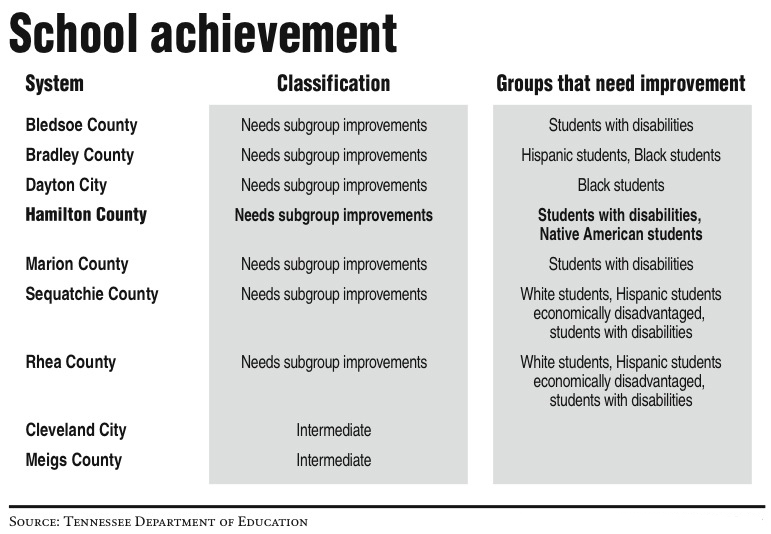WHAT THE LABELS MEANThe Tennessee Department of Education classifies districts into four categories based on overall student achievement and how fast districts are closing achievement gaps between groups of students.• The state’s five “Exemplary” districts met most goals for overall achievement and achievement gap closure, as well as ensured that all subgroups improved.• The state’s 32 “Intermediate” districts met most goals for either overall achievement or gap closure, but not both.• The state’s three “In Need of Improvement” districts failed to reach a majority of their goals for both achievement and gap closure.• The state’s 96 districts “In Need of Subgroup Improvement” may reach their achievement and gap closure goals but experience declines among particular groups of students.
About half of Tennessee school districts — including Hamilton County — need to improve the academic performance for students with disabilities, according to the latest data released by the Tennessee Department of Education.
On Tuesday, the department released its accountability classifications — basically the grades the state gives school districts based on their performance on state assessments. The new accountability model, which in 2012 replaced the No Child Left Behind and Adequate Yearly Progress models, judges districts on their overall student achievement, as well as their closing achievement gaps, like the historical gap in performance between white students and racial minorities or poor and nonpoor students.
Results for 2013 show most districts need to improve performance in at least one of their so-called student subgroups, like racial minorities, students with disabilities, poor students or those whose primary language is not English. Of the state’s 137 districts, 96 were identified as needing improvement among some groups, 67 of which were for the students with disabilities category.
“We talked about this at the state level. Students with disabilities was definitely an area we struggled with and we need to improve,” said Kelli Gauthier, spokeswoman for the Tennessee Department of Education. “And Hamilton County mirrored that. They’re one of many.”
Aside from that issue, Hamilton County was dinged for needing improvement among Native American students, though that population is much smaller than that of disabled students. Of about 42,000 students in 2012, about 75 were Native Americans and about 7,000 had a disability of some kind.
Improving the achievement in these groups is important to the district, said Kirk Kelly, director of testing and accountability. But closing achievement gaps is tricky work, because school officials want to see all students improve.
“What we’re seeing right now is that both groups: — students with disabilities and students without disabilities — are improving,” Kelly said. “But the gaps between them are getting bigger or staying about the same.”
Contact staff writer Kevin Hardy at 423-757-7249 or khardy@timesfreepress.com.


